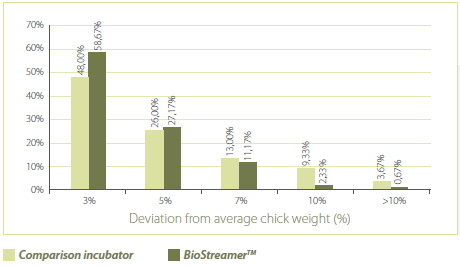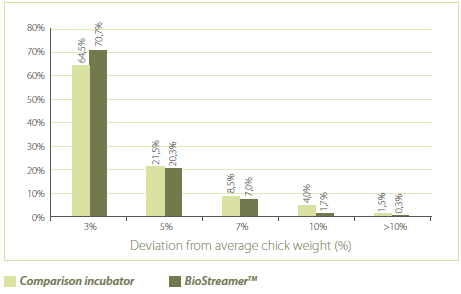



Assessing Chick Uniformity
Chick uniformity is the most important criterion for predicting post-hatch performance, says senior incubationist, Roger Banwell, in the latest newsletter from Petersime.
Chick uniformity is defined by many factors related to genetics, environment, handling procedures and, last but not least, the incubation equipment. This article presents the results of a study on the influence of incubators on chick uniformity.
Critical Factors Prior to Incubation
Development of the avian embryo begins immediately after fertilization in the infundibulum and oviduct and subsequently in the shell gland, where the egg white, membranes and shell are deposited over 24 to 26 hours.
There is considerable variability in embryonic development at oviposition (egg laying) due to the genetic strain, the age of the hen, and the position of an egg in the sequence. Even the body temperature of the hen (40.0 to 41.5°C) may affect the speed of early embryonic development.
When it comes to assessing the uniformity of embryonic development and growth achieved in your incubators, critical factors such as farm egg collection times and transportation conditions all play a role.
During storage, cell death occurs. The total number of living cells (60,000 to 80,000) is reduced, and sometimes even halved. In such extreme cases, a partial degree of development can continue at so-called ‘sub-threshold temperatures’. Both the egg storage conditions and the uniformity of these conditions have a significant effect.
Embryonic development and growth in the incubator depend primarily on energy transfer in the form of heat. The rate of heat transfer is governed by ambient conditions (air temperature and humidity) along with air movement. In a large–scale commercial incubator, air movement plays a significant role as the large egg mass/air space ratio dictates the need for the surrounding air to be agitated in order to create relatively uniform conditions throughout the entire egg mass.
Because of these variables, along with the tremendous range in egg sizes and weights produced from the same flock sources, simply measuring air temperature or average chick weights cannot be considered a reliable indicator of uniformity generated throughout the incubation equipment.
Set-up of the Study
In the following study, the eggs were preselected and the rate of embryonic development and growth was used as an accurate indicator of incubator uniformity.
In order to negate the effect of the "critical factors prior to incubation" as much as possible, eggs were taken from the same flock type, age and farm. They were all stored no longer than three days. The average egg weight was recorded and only eggs within ±1.5 per cent of the average were selected for the test. A sample size of 1,125 eggs per comparative incubator (2 × 1,125 = 2,250 in total) were evenly distributed with reference to air distribution source in both the horizontal (front, middle and rear) and vertical (upper, middle and lower) positions.
This creates a three-dimensional image of the final chick/egg weight ratio generated throughout the incubation equipment.
Study Findings
Two different incubators were used with alternative airflow mixing systems: a Petersime BioStreamer™ and another incubator. The final data were analysed and presented in a format that shows the percentage of chicks within a deviation of 3, 5, 7, 10 or over 10 per cent of the average chick/egg weight ratio.
Trial 1

The first trial was conducted with a young (32 week+) flock strain. The BioStreamer™ achieved 85.84 per cent of the day-old chicks within five per cent of the average chick/egg weight ratio, whereas the comparison incubator achieved 74.00 per cent: an improvement of 11.84 per cent.
Trial 2

The second trial was conducted with a different flock strain at a higher age (44 week+). This trial recorded the BioStreamer achieving 91.00 per cent within five per cent of the average chick/egg weight ratio, with the comparison incubator achieving 86.00 per cent: an improvement of five per cent.
Post–Hatch Performance
The table below shows an overall and consistent benefit in uniformity in terms of increased bird weight and reduced mortality and feed conversion ratios (FCRs).
The gains achieved concern the entire batch, including the chicks that deviated more than five per cent from the average chick/egg weight ratio.
| Post-hatch data: summary | |||
| Trial series | Final bird weight | Mortality | FCR |
|---|---|---|---|
| Trial 1 | +7g | -0.70% | -0.02 |
| Trial 2 | +29g | -1.40% | -0.03 |
Benefits through Improved Uniformity
It is difficult to assess the potential for greater gains through increased numbers of grade A birds and subsequent increased numbers of premium–priced birds, as this depends entirely on the specific business models of the individual hatcheries.
The degree of gain achieved through improved uniformity is difficult to put in absolute currency value. However, it is clear that the question is not "is there added value" but rather "how much".
February 2012








